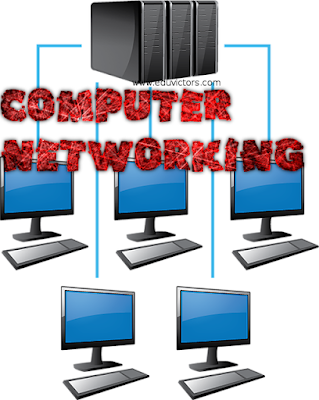CBSE Class 12 - Computer Science / Informatics Practices - Computer Networking - Q and A (#cbseNotes)
Computer Networking

Q1: What is a computer network?
Answer: A computer network is a collection of interconnected computers. Two computers are said to be interconnected if they are capable of sharing hardware, software and exchanging information.
Q2: Name the architectures that are involved in network design?
Answer:
① Peer to peer (P2P)
② Client - Server
③ Hybrid of client-server and P2P
Q3: List the network components used to connect computers.
Answer:
① Network interface card (NIC) - A network card generally connected to or part of motherboard of a computer.
② Network medium - A cable conncted to NIC.
③ Interconnecting device - It can be hubs, modems, switches, routers, and wireless access points.
 |
| Network Cable |
Q4: What are the advantages for Networking?
Answer: Advantages for Networking are:
① Resource sharing
② Reliability
③ Cost factor
④ Communication medium
⑤ Central Storage of data
Q5(HOTS): What do you mean by a backbone network?
Answer: A backbone network is a network that is used as a backbone to connect the connect several LAN’S together to form a WAN. FDDI (Fiber Distribute Data Interface) is such a network. FDDI is a high performance fiber optic token ring LAN running at 100 Mbps over distances up to 200 kms with up to 1000 stations connected.
Q6: Define the following :
ⅰ Data channel
ⅱ Baud
ⅲ bps
ⅳ Bps
ⅴ Bandwidth
Answer:
ⅰ Data channel: A data channel is a medium used to carry information or data from one point to the other.
ⅱ Baud: Baud is the unit of measurment for the information carrying capacity of a communication channel.It is synonymous with bits per second.
ⅲ bps: bits per second. It refers to a thousand bits transmitted per second.
ⅳ Bps: bytes per second.It refers to a thousand bytes transmitted per second.
ⅴ Bandwidth: It refers to the diffrence between the highest and lowest fequencies of a transmission channel.This term is also sometimes used to refer to the amount of information travelling through a single channel at any one point of time.
Q7: What factors affect data transmission?
Answer: Several factors affect how data is transmitted. These include the following:
① Transmission rate-Frequency and bandwidth
② Line Configurations-Point to point versus multipoint.
③ Serial and Parallel transmission
④ Direction of transmission-Simplex, Half Duplex, and Full Duplex
⑤ Transmission Mode-Asynchronous and synchronous.
⑥ Circuit switching and Packet switching
⑦ Multiplexing
⑧ Protocols
Q8: List any three applications of networking.
Answer: Application of Networking:
① Sharing
② Access to remote database
③ Communication facilities
Q9: What is a MAC address?
Answer: It refers to the physical address assigned by the NIC manufacturer. A MAC address is a 6 byte address with each byte separated by a colon. For example: 22:B4:02:6C:2E:F1. The first three bytes refer to manufacturer ID and last three card numbers.
Q10: List the different switching techniques used in networking?
Answer:
① Circuit Switching
② Message Switching
③ Packet Switching
Q11: Name the different types of transmission media commonly used in networking?
Answer:
① Twisted pair cable
② Co-axial Cables
③ Optical fiber
④ Infrared
⑤ Radio Waves
⑥ Microwave Communication
⑦ Satellite Link
Q12: What is RJ45 connector?
Answer: The RJ-45(Registered Jack) connectors are the plug-in devices used in the networking and telecommunications applications. They are used primarily for connecting LANs, particularly ethernet.
Q13: Define hub.
Answer: A hub is a hardware device used to connect several computers together. Hubs can be either active or passive. Hubs usually can support 8, 12 or 24 RJ45 ports
Q14: Define modem.
Answer: MOdulator-DEModulator (or Modem) is a device that connects telephone line to computer. It converts digital signal to analog signal and vice versa.
Q15: What is a switch? Which is faster between hub and switch?
Answer: Switch is an intelligent hub, which is used to segment networks into different sub network called subnets. Switch is faster and efficient over hub due to good traffic management capability.
 |
| Wireless router |
Q16: Define the following:
ⅰ Repeater
ⅱ Router
ⅲ Gateway
ⅳ Bridge
Answer:
ⅰ Repeater: A repeater is a device that amplifies signals transmitted on the network. It is used in long network lines beyond 70m.
ⅱ Router: The device which connects two similar networks and can handle different protocols.
ⅲ Gateway: It is a device that connects dissimilar networks.
ⅳ Bridge: A device that connects two similar networks.
Comments
Post a Comment